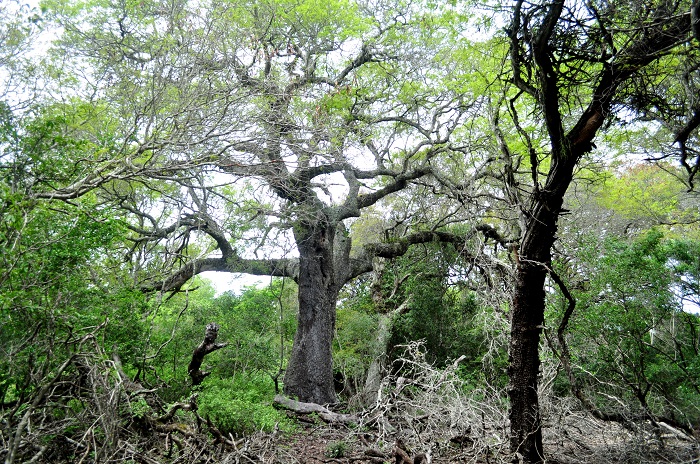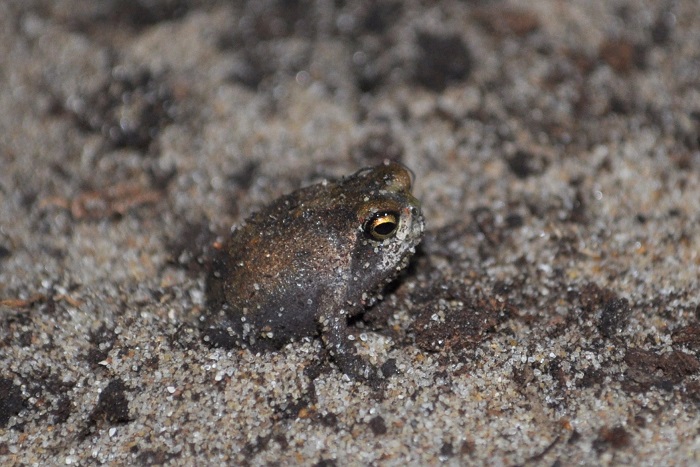Cover photo by M. Douglas.
Find the Whistling Rain Frog in the FBIS database (Freshwater Biodiversity Information System) here.
Family Brevicepitidae
Identification
Male Whistling Rain Frogs range from 22–26.2 mm (N = 14) in body length. Morphologically, the species is difficult to separate from B. mossambicus and B. bagginsi. The Whistling Rain Frog can be easily distinguished from all Breviceps species by its unique advertisement call. Vocalisations consist of a series of long, unpulsed, high-pitched whistles. Each calls varies from 0.6–1.98 s in duration and from 2755–3468 Hz in frequency (N = 20; Minter 2003).

Near Hluhluwe, KwaZulu-Natal
Photo by M. Booysens
Habitat
The Whistling Rain Frogs inhabits a variety of vegetation types within the Forest and Savanna biomes. It is found in the dense, herbaceous undercover of the Sand Forest at St Lucia and Dukuduku, Afromontane Forest on the northern slopes of the Lebombo Mountains at Jozini, and the sandy rhyolitic soils of the Lebombo Arid Mountain Bushveld at Mlawula Nature Reserve (Swaziland) and Komatipoort (Minter 1998, 2003).

False Bay, iSimangaliso Wetland Park, KwaZulu-Natal
Photo by Ryan Tippett
At St Lucia, B. sopranus occurs in forest while B. mossambicus occupies the open grassy areas between forest patches. In bushveld habitats, B. sopranus occurs in sympatry with B. adspersus.
Behaviour
The Whistling Rain Frog breeds between early October and early January. Choruses develop at any time of day, during light to heavy rain, but unless this is followed by drizzle or heavy mist, cease immediately afterward. Calling males often take up elevated positions on fallen branches or small plants, or call from the soil surface (Minter 1998, 2003). Amplexus and oviposition have not been observed.

Kosi Bay, iSimangaliso Wetland Park, KwaZulu-Natal
Photo by Ryan Tippett
Status and Conservation
Status
The Whistling Rain Frog is a recently described species (Minter 2003). Since the distribution and biology of this species are poorly known, an accurate assessment of its conservation status is not possible at present. It is therefore assigned to the category “Data Deficient”. The species occurs in the Hluhluwe and Mkuze Game Reserves and the Greater St Lucia Wetland National Park in South Africa, and the Mlawula Nature Reserve in Swaziland.

Kosi Bay, iSimangaliso Wetland Park, KwaZulu-Natal
Photo by Ryan Tippett
Threats
Outside of these protected areas much of the natural habitat of this species has been destroyed by the farming of crops such as sugarcane, and by deforestation in the Dukuduku forest.
Conservation actions
Distribution, life history and ecological data of the Whistling Rain Frog are urgently needed to adequately address the conservation needs of this species.
Distribution

The Whistling Rain Frog is known only from the atlas region at present, but may also occur in southern Mozambique. It has been recorded as far south as Mtunzini (2831DD) in KwaZulu-Natal, and it follows the Lebombo Mountains northward along the eastern border of Swaziland to Komatipoort (2531BD) in Mpumalanga (Passmore and Carruthers 1995; Minter 1998, 2003).
The atlas data are accurate but incomplete. The unusual call may easily be mistaken for that of an insect or bird, particularly when heard during the day. This may have contributed to the paucity of distribution data.

Kosi Bay, iSimangaliso Wetland Park, KwaZulu-Natal
Photo by Ryan Tippett
Further Resources
The use of photographs by M. Booysens and M. Douglas is acknowledged. Other photographs by Ryan Tippett.
Whistling Rain Frog Breviceps sopranus Minter, 2003
Other Common Names: Fluitreënpadda (Afrikaans)
Recommended citation format: Minter, LR; Tippett, RM. (2025). Whistling Rain Frog Breviceps sopranus. Biodiversity and Development Institute, Cape Town. Available online at https://thebdi.org/2021/11/15/whistling-rain-frog-breviceps-sopranus/
This species text has been updated and expanded from the text in the
2004 frog atlas: Minter, LR. (2004). Whistling Rain Frog Breviceps sopranus. In Minter LR et al 2004.
References:
Minter, LR; Burger, M; Harrison, JA; Braack, HH; Bishop, PJ; Kloepfer, D. (Editors). (2004). Atlas and Red Data Book of the Frogs of South Africa, Lesotho and Swaziland. Smithsonian Institution, Washington, and Avian Demography
Unit, Cape Town.
Carruthers, V; du Preez, L. (2017). Frogs of southern Africa: A Complete Guide. Struik Nature, Cape Town.
Channing, A. (2001) Amphibians of Central and Southern Africa. Protea Book House, Pretoria
Claus, B; Claus, R. (2002). Common Amphibians and Reptiles of Botswana. Gamsberg Macmillan, Windhoek.

